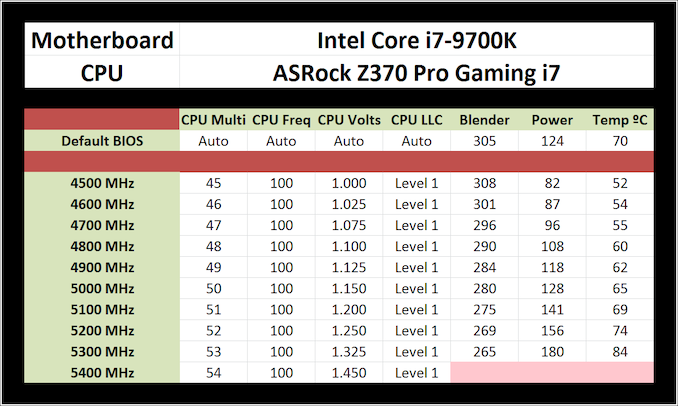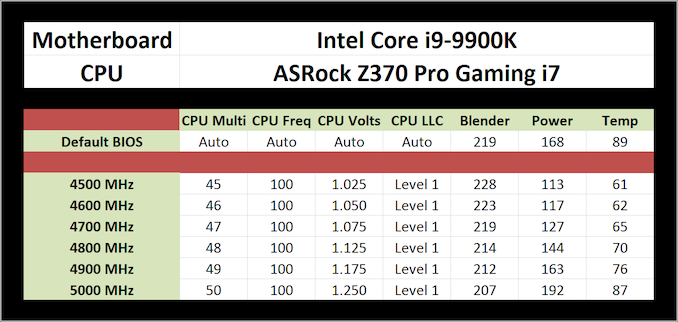The Intel 9th Gen Review: Core i9-9900K, Core i7-9700K and Core i5-9600K Tested
by Ian Cutress on October 19, 2018 9:00 AM EST- Posted in
- CPUs
- Intel
- Coffee Lake
- 14++
- Core 9th Gen
- Core-S
- i9-9900K
- i7-9700K
- i5-9600K
Overclocking
With the upgraded thermal interface between the processor and the heatspreader, from paste to solder, Intel is leaning on the fact that these overclockable processors should be more overclockable than previous generations. We’ve only had time to test the Core i9-9900K and i7-9700K on this, so we took them for a spin.
Our overclocking methodology is simple. We set the Load Line Calibration to static (or level 1 for this ASRock Z370 motherboard), set the frequency to 4.5 GHz, the voltage to 1.000 volts, and run our tests. If successfully stable, we record the power and performance, and then increase the CPU multiplier. If the system fails, we increase the voltage by +0.025 volts. The overclocking ends when the temperatures get too high (85C+).
For our new test suite comes new overclocking features. As mentioned in the previous page, our software loading for power measurement is POV-Ray, which can thrash a processor quite harshly. POV-Ray also does a good job on stability, but is not a substantial enough test – for that we use our Blender workload, which pushes the cores and the memory, and lasts about 5 minutes on an 8 core processor.
Results as follows:
For the Core i7-9700K, we hit 5.3 GHz very easily, for a small bump in power and temperature. For 5.4 GHz, we could boot into the operating system but it was in no way stable – we were ultimately voltage/temperature limited at this case. But an eight core, eight thread 5.3 GHz CPU at 180W for $374? Almost unimaginable a year ago.
Overclocking the Core i9-9900K was not as fruitful. The best bit about this overclock is the 4.7 GHz value: by using our own voltage settings, we reduced power consumption by 41W, almost 25% of the total power, and also reduced temperatures by 24ºC. That's a safe idea. Even 4.8 GHz and 4.9 GHz was reasonable, but the temperatures at 5.0 GHz might not be for everyone. When all cores and threads are loaded, this is one warm chip.












274 Comments
View All Comments
0ldman79 - Friday, October 19, 2018 - link
AMD needs to improve their AVX processing as well, but they've got Intel in a bit of a predicament.Hifihedgehog - Friday, October 19, 2018 - link
Ladies and gentlemen, I present to you...Intel’s FX 9000 series.
Now even hotter and more power hungry than ever!
mapesdhs - Sunday, October 21, 2018 - link
It reminds me a lot of the P4 days when Intel just had to shove clocks through the roof to remain relevant. And I don't know why tech sites are salivating so much on oc levels that are barely any better than a chip's max turbo, it's a far cry from the days of SB, especially since one can run a 2700K at 5GHz with sensible voltage and good temps using a simple air cooler (ordinary TRUE works fine) and one fan, without high noise (I know, I've built seven of them so far). To me, the oc'ing potential of the 9K series is just boring, especially since the cost is so high that for gaming one is far better off buying a 2700X, 8700K (or many other options) and using the save to get a better GPU.sgeocla - Friday, October 19, 2018 - link
Why compare to the TR 1920x ($799) and not to the TR 2950X ($899)?The TR 2950X kills it in almost every productivity benchmark even against i-9 9900k.
Not even mentioning the 9th gen power consumption.
Yorgos - Friday, October 19, 2018 - link
don't bother with the review.They show you the results that makes intel seem good.
Intel/Purch media have failed to show to the people that they exceed even Threadripper's TDP in order to fight Zen.
Desperate moves for desperate times.
Better look somewhere else for an unbiased review.
mkaibear - Friday, October 19, 2018 - link
What, you mean apart from page 21 where it shows that it almost doubles Threadripper's TDP for the same core count CPU and is 50% greater than the one which has 50% more cores than it does?Some reading comprehension lessons needed I think.
yeeeeman - Friday, October 19, 2018 - link
The 9900K looks like a nice CPU, but damn that power consumption is stupidly high. It is almost twice what the 2700X consumes.Hifihedgehog - Friday, October 19, 2018 - link
*High-end AIO required.AGS3 - Friday, October 19, 2018 - link
Twice the CPU - 8 cores over 5Ghz :)AutomaticTaco - Saturday, October 20, 2018 - link
Revised down. The first motherboard they used was extremely higher voltage settings.https://www.anandtech.com/show/13400/intel-9th-gen...